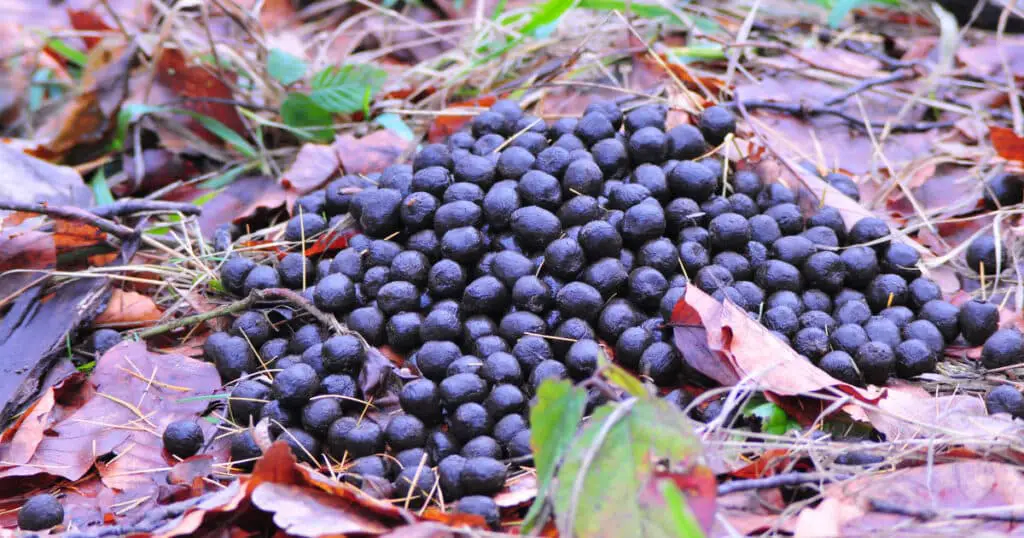Wait, why should you want to know about deer poop? Well, there are lots of reasons. If you are a hunter, you probably already know one of them. Recognizing deer poop can help find your prey. But almost all people who spend a lot of time in the outdoors like to have this information, too. Also, if you suspect deer are invading your property or garden, checking for their droppings is a helpful way of confirming the presence of deer. So what does deer poop look like? And what can you learn about the deer by their droppings?
In today’s article we’ll explain everything you never knew you’d want to know about deer dung.
So, What do Deer Droppings Look Like?
Deer droppings (feces) are also referred to as scat or stool. Deer poop generally has a bullet-shaped or pellet-like appearance. More specifically, each dropping usually has different shapes, but they are pointed at one end and have an indentation at the other. Deer scat’s color changes depending on the animal’s diet. It can be anything from black to brown to green. The color of a deer’s droppings can help you figure out what it eats and what kind of bedding it tends to use.
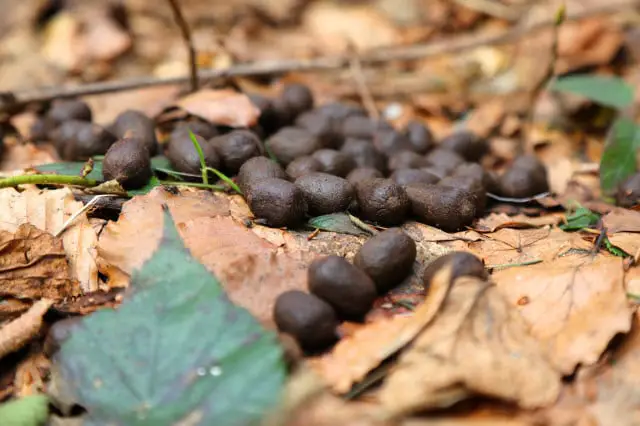
If deer scat still seems fresh and is moist and warm, this probably means that there are deer in the area. Deer scat is smaller than you would expect from an animal that size. The fact that it is so tiny means hunters can identify it easily.
When you find deer scat, it’s usually a pile of small pellets. In general, these will be stuck together in a solid pile.
Deer Droppings Hint at Diet
You can get an idea of what a deer eats by looking at its scat. If a deer mostly eats acorns, leaves, and twigs, they have separate, firm, and round poops. Deer which primarily live on clover, alfalfa, apples, and forbs of other kinds will probably have lump droppings.
If you find fresh (warm and steaming) deer poop in a certain area, there is a good chance there are deer in the area and they are eating a lot of the foods there. Deer poop that is older will get smaller, drier, and start crumbling.
When you see black and brown deer scats, that’s generally because there is bile and blood cell content in them.
Why are Deer Poop Pellets So Small?
The explanation is pretty simple. It’s because of the shape and function of the animal’s colon.
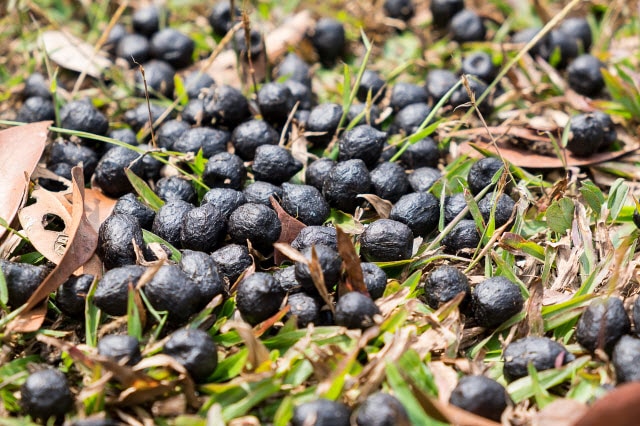
A deer’s colon uses an opening and closing rhythm with its sphincter. The way the deer colon’s sphincter works results in roundish, small pellets. Some other animals (like sheep, goats, and rabbits) produce droppings in a similar way.
Other Facts About Deer Poop
Well, we’re already talking about it, so we might as well jump in with two feet. Let’s learn a little more about deer droppings.
Moisture and Color
Looking at deer poop’s moisture and coloration can help you figure out how old a pile of deer poop is.
If the droppings still look wet, shiny, and dark in color, they are probably less than 12 hours old. If the droppings are a lighter color and they look dry, the poop is probably a minimum of 24 hours old. It’s possible it could be even several days old.
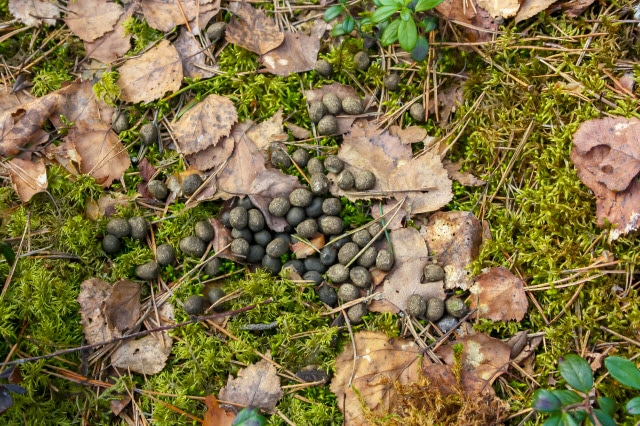
The longer droppings have been sitting on the ground, the more fibrous they tend to be. If a scat looks broken or crusty, it’s probably more than a week old.
Buck Scat Piles are Larger
Male deer (bucks) often produce more pellets in a pile than does (female deer). On average, there are between 70 and 80 pellets in a buck pile, while a doe pile will usually have between 50 and 60.
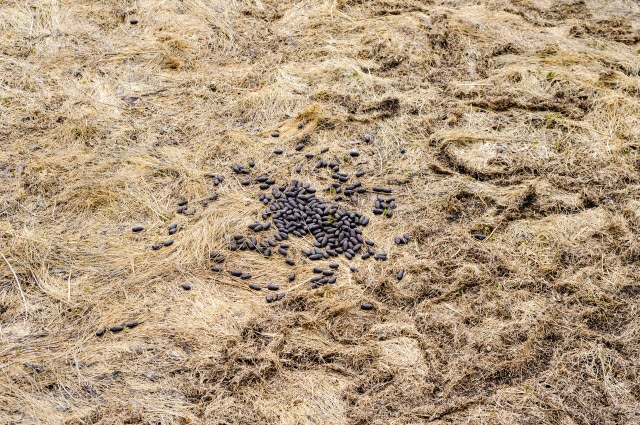
For hunters or outdoorsmen interested in tracking and observing deer, the size of the pile of droppings can give you some clues about the size of the buck or does in the area.
Deer Produce a Lot of Scat
Wondering how often deer poop? A lot. In the fall and winter months, whitetail deer tend to produce scat between 10 and 15 times each day. This becomes even more frequent in the summer, when they will defecate between 20 and 30 times each day.
Patterns of deer defecation are well-known by wildlife authorities, and they are extremely predictable. In fact, some wildlife agencies can even make quite accurate guesses at deer populations from the poop they find.
Baby Deer Poop at Specific Times
A baby deer (fawn) will only poop when the mother deer stimulates them. This happens during nursing (when the fawn drinks milk from the mother).
Mother deer will frequently eat the fawn’s poop, in order to reduce the likelihood of predators tracking them down. Mother deer bring their fawns to areas far away from where they hide out during the day to nurse and let them empty their bowels.
Once they hide their fawn again, the mother will leave them to reduce the risk of them being discovered by a predator.
Loose Droppings Mean a Specific Diet
If you find loose deer droppings, it probably means that the deer has eaten alfalfa or fruit. You may find there are orchards nearby with fruit such as plums, crabapples, apples, persimmons, and pears.
What about Droppings in Heavy Cover?
If you find droppings that appear fresh (for example, they’re still soft, warm, and steaming) in an area with (or near) heavy cover, you are probably approaching the place where a buck beds down and sleeps. This means you have probably found the trail he frequents.
If this happens to you, go to the closest significant food source. Stay on that route and set up a treestand. This is a great way to do an afternoon hunt for a buck.
Alternatively, do this in the morning. You may see the buck as he returns from feeding during the night. Deer are not nocturnal, they’re crepuscular … meaning they’re most active in the twilight hours at the start and end of each day.
What about Droppings in an Open Area?
If you find deer droppings in an open space, it’s probably a deer feeding spot. This means this could be a good place for hunting in the late afternoon.
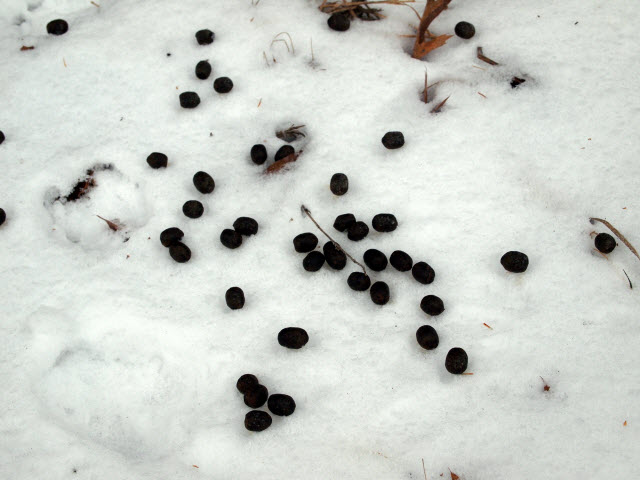
Look for a nearby transition corridor that a deer might use as a funnel in from heavy cover (where they probably bed down).
You Cannot Tell a Deer’s Sex from its Scat
While it’s true that a larger pile of scat probably means a larger deer (and in many cases this is a buck), you cannot definitively tell a deer’s sex from its scat.
Rather than sex, deer scat indicates the size of the animal and diet.
Be aware that a buck may not always leave a much larger pile than a doe. In fact, even when it is larger, it is often not much larger. Even experts cannot differentiate buck and doe droppings just by looking at or examining them.
Some Hunters Use it for Cover
Unless you’re a truly devoted hunter and determined to finally get that trophy buck, you probably won’t want to do this. But some hunters will actually pick up the poop and rub it into their clothing, using the deer droppings as a cover scent.
Poop Can Indicate a Bedding or Feeding Area
Deer often poop near their bedding area. A clue you have found a deer bedding area might be if you find numerous piles of poop. If you see a spot that looks like a deer bed, then you know this is a bedding area. A deer poop pile near a bedding area will usually be clumped or uniform.
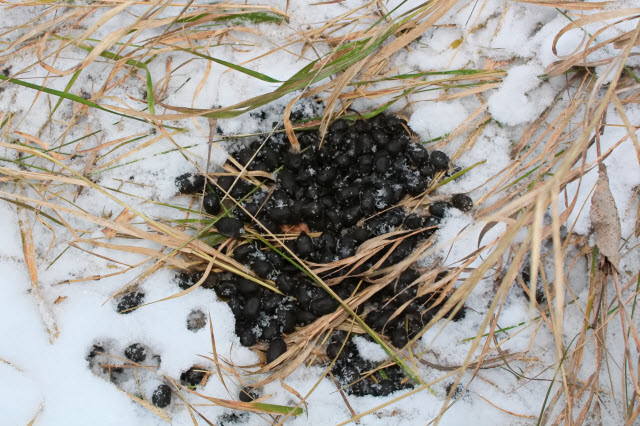
Deer also tend to poop at the same time they are eating, so you will often find their droppings in a feeding area as well. These piles may be less uniform in appearance, or more spread out. The deer may poop while moving and grazing here.
What Can You Learn About a Deer from its Droppings?
Taking a close look at a deer’s droppings can tell you about its diet.
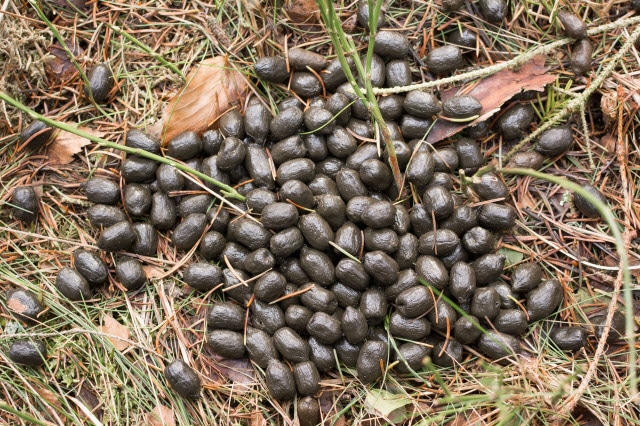
If the deer is getting a lot of water in its forage, it will impact the shape and composition of the scat. Piles of firm pellets mean that the deer probably has eaten woody browse (twigs, leaves, and buds), hard mast (nuts and acorns), grain (oats, soybeans, and corn).
If the scat looks softer and perhaps long in shape, or if you find it in singles instead of piles, the deer probably ate soft mast (peaches, pears, plums, persimmons, peaches, and other fruits), forbs, and/or broadleaf plants.
In general, the larger the pile of deer scat you find, the larger the deer is likely to be. If you find a large pile, it probably came from an animal between 150 and 250 pounds. Fawns and does that weigh between 75 and 125 pounds usually produce smaller scat piles.
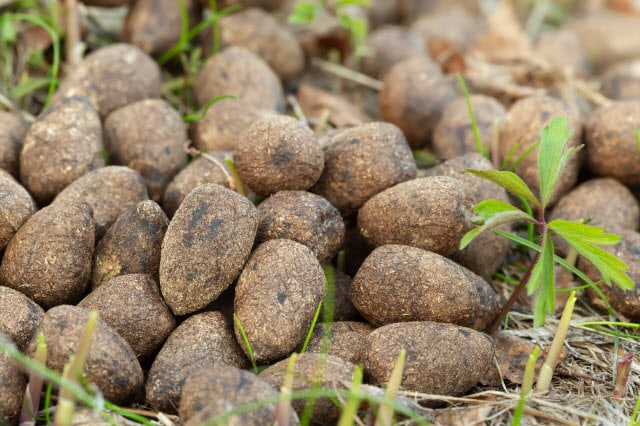
If you are a hunter looking for a buck in the fall it doesn’t hurt to look for doe droppings. Bucks will be looking for them too, so they can find potential mates.
If you find a lot of deer poop in a particular area, this will probably be a good place for hunting the animal. Deer will often leave their scat near places where they bed down, where they find water, and where they find food.
The Risks of Contact with Deer Droppings
Be careful when examining deer droppings. There can be dangerous diseases in them. For example, a deer with chronic wasting disease (CWD) will leave droppings that have disease prions in them. No one knows whether humans are able to get this disease, but there is a possibility. After all, CWD is related to the well-known mad cow disease and there is a lethal variant of that which people have contracted.
Deer Poop vs Other Animal Droppings
The table below will help you identify the droppings you find in the woods.
| Animal | Size | Color | Shape |
|---|---|---|---|
| Deer | Small, but it is usually in piles of other poops. Sometimes clumped in piles, especially in the fall and summer. | In the fall and summer, tends to be black or dark brown. In the winter, tends to have a lighter color and harder consistency. | Round or roundish, a bit like a chocolate-covered raisin or nut |
| Raccoon | Medium-sized. Can look a bit like dog feces. | A reddish shade to black. May even be white. | Oblong in shape |
| Fox | Usually around a few inches in length. | Ranges from light to dark brown. | Ends of each piece have pointed ends. |
| Elk | A little bigger than deer poop, but similar in shape. The poops are pellets. The same as deer scat, they tend to be found in piles and can sometimes be stuck together. The droppings of large elk can sometimes look like cow poop. | Dark brown to black, or lighter in color other times of the year. | Can have concave ends and dimples in the body of the poop. |
| Coyote | Large for the size of the animal. It tends to look like wolf poop. | Dark brown in the winter, and you will find more bone and fur fragments (from prey) during that season. | Tends to have a twisted shape, almost like rope. This is because of the fur in coyote droppings, caused by the prey coyote eat. Coyotes eat more vegetation in the summer, and during that season the poop will usually be lighter in color. This is because of fruit and berries that they eat during that time of year. |
| Pronghorn | Similar to deer | Brown. Often found in same place where animal urinated. The pronghorn digs into the ground to create a depression, and the urinates and defecates. | More of an oblong or oval shape than deer pellets |
| Mountain Lion | Can be as long as 5 inches (with a larger than one inch diameter). | Brown. You will often see clues of what the mountain lion has eaten in their scat. For example, there is often fur from their prey. | Blunt ends and segmented shape. Mountain lions often cover their poop with dirt. |
| Bobcat | Between 3 and 5 inches in length | Brown. Like other animals, you will often see clues of what the bobcat has eaten in their scat. | Shaped like a tube, with a diameter between half an inch and one inch. |
| Bear | Large and long. Can be as long as 12 inches. The diameter may be between one and a half inches and two and a half inches. | Brown, but exact color will depend on diet. You will often find clues on the bear’s diet in their poop. | Tube-like shape, with blunt ends or some tapering. This changes depending on diet. |
Now You Know What Deer Poop Looks Like
While deer poop is just the final result of how deer digestive systems work, understanding what it looks like and why can tell you a lot about the local deer population, its size, and health.
Deer droppings can give you hints about the deer’s diet, its whereabouts (including feeding and sleeping areas), and its size. No wonder hunters spend so much time looking for deer poop and examining it.
If you are a hunter or thinking about trying your hand at the sport, you will have to learn about the scat of different species and what different characteristics of their droppings tell you about the animals around you in the woods.

